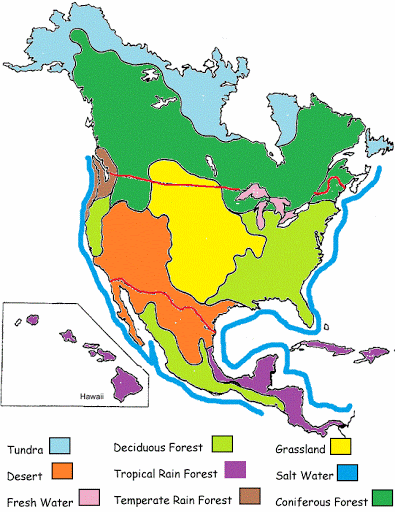North America Biomes Worksheet: Explore and Learn

In the vast and diverse continent of North America, a variety of biomes stretch from the icy tundra of the north to the tropical rainforests near the equator. These biomes each host unique sets of flora and fauna, climate conditions, and environmental challenges. Understanding these ecosystems is not just an academic exercise but a step towards appreciating the biodiversity that North America holds. Let's delve into each biome through an informative worksheet-style exploration.
Ecology of North American Biomes

Here, we'll categorize and discuss the major North American biomes to enhance our understanding of ecological diversity:
Tundra


- Location: Northernmost parts of North America including Alaska and Northern Canada.
- Climate: Extremely cold with a very short growing season.
- Flora: Mosses, lichens, sedges, dwarf shrubs, and some hardy wildflowers.
- Fauna: Animals like caribou, polar bears, Arctic foxes, and migratory birds.
🐻 Note: The tundra is particularly sensitive to climate change due to permafrost melting.
Boreal Forest (Taiga)

- Location: Wide band below the tundra, reaching into parts of Canada and Alaska.
- Climate: Long, harsh winters and short, cool summers.
- Flora: Dominated by coniferous trees like spruce, fir, pine, and larch.
- Fauna: Moose, bears, lynx, wolves, and numerous bird species.
🌲 Note: Boreal forests are known for their ability to adapt to cold climates through a variety of survival strategies.
Temperate Deciduous Forest

- Location: Central and Eastern United States, extending into Canada.
- Climate: Warm summers, cold winters, and moderate precipitation.
- Flora: Oaks, maples, beech, birches, and many flowering species.
- Fauna: Deer, foxes, raccoons, squirrels, and numerous bird species.
🍁 Note: This biome showcases the spectacular autumnal color change which can attract tourists.
Grassland (Prairie)

- Location: Central North America from Canada to Texas.
- Climate: Semi-arid to sub-humid; hot summers, cold winters.
- Flora: Grasses dominate, interspersed with wildflowers and shrubs.
- Fauna: Bison, pronghorn, coyotes, snakes, and various rodents.
Desert

- Location: Southwestern U.S. and into Mexico.
- Climate: Hot and dry with very low rainfall.
- Flora: Cacti, yucca, creosote bushes, and other drought-resistant plants.
- Fauna: Rattlesnakes, lizards, small mammals like kangaroo rats, and desert adapted insects.
Temperate Rainforest

- Location: Northwestern U.S. and Canada along the Pacific Coast.
- Climate: High rainfall with mild temperatures.
- Flora: Douglas fir, western hemlock, and giant trees like Sitka spruce.
- Fauna: Bears, salmon, various birds, and amphibians like salamanders.
Tropical Rainforest

- Location: A small stretch in the Florida Everglades and Central America.
- Climate: Warm and wet year-round.
- Flora: Orchids, bromeliads, palms, ferns, and towering trees.
- Fauna: Jaguars, monkeys, parrots, butterflies, and diverse insect species.
🌴 Note: Though small in North America, tropical rainforests are some of the most biodiverse ecosystems on earth.
Table: Key Features of North American Biomes

| Biome | Climate | Typical Vegetation | Key Animal Species |
|---|---|---|---|
| Tundra | Extremely cold | Mosses, Lichens, Shrubs | Caribou, Polar Bears |
| Boreal Forest | Cold Winters, Short Summers | Coniferous Trees | Moose, Bears |
| Deciduous Forest | Seasonal, Moderate Rainfall | Broad-Leaved Trees | Deer, Foxes |
| Grassland | Hot Summers, Cold Winters | Grasses, Wildflowers | Bison, Coyotes |
| Desert | Hot and Dry | Cacti, Shrubs | Snakes, Kangaroo Rats |
| Temperate Rainforest | Mild, High Rainfall | Conifers, Giant Ferns | Salmon, Bears |
| Tropical Rainforest | Warm, Wet Year-Round | Orchids, Tropical Trees | Jaguars, Monkeys |

The exploration of North American biomes reveals a tapestry of ecosystems, each with its own unique charm and challenges. These diverse landscapes not only offer educational value but also play critical roles in the global ecosystem:
- They provide habitats for thousands of species, many of which are threatened or endangered.
- Biomes influence local and global climates through processes like carbon sequestration and water cycling.
- They offer opportunities for scientific research into how life adapts to different environments.
- North American biomes also have cultural significance for various indigenous populations.
By understanding these biomes, we gain insights into how ecosystems function and interact, allowing us to appreciate their beauty and advocate for their conservation. From the tundra to the tropics, the biodiversity of North America is not just a marvel of nature but a crucial part of the planet's health.
What are the main threats to North American biomes?

+
Main threats include climate change, habitat destruction, pollution, invasive species, and over-exploitation of natural resources.
How do biomes affect the climate?

+
Biomes impact local and global climates through the release or absorption of greenhouse gases, water vapor exchange, and the creation of microclimates within their vast expanses.
Can biomes change over time?
+Yes, biomes can evolve naturally or through human influence. Factors like temperature changes, precipitation shifts, and human activities can all lead to biome transitions or degradation.



